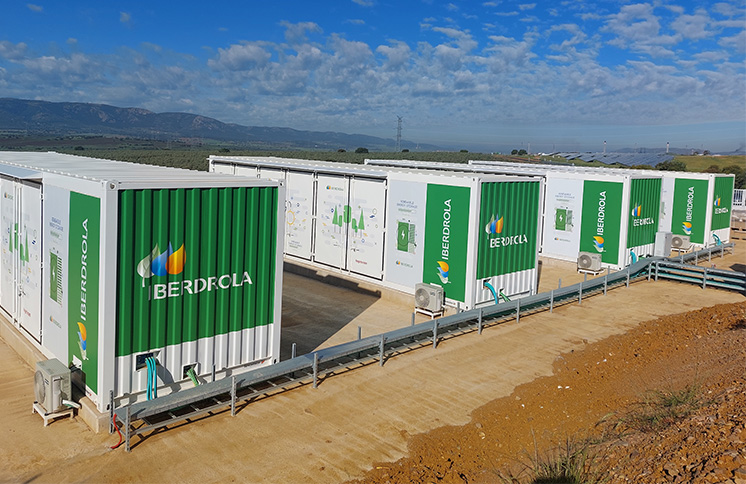Battery sizes
Battery dimensions: their importance and their influence on performance
R&D Energy efficiency Energy storage
Batteries play a key role in the storage of renewable energies in order to conserve surplus production and supply it whenever it is needed. There is a wide range of batteries available on the market, made from different materials and in a variety of sizes. Discover the importance of battery dimensions and how they affect performance in different applications, from electric vehicles to solar power systems.

Renewable energies have become the most important solutions for tackling climate change and accelerating the energy transition. But energies, such as solar or wind, are highly dependent on weather resources with intermittent and fluctuating characteristics.
To regularise these variabilities, battery energy storage systems have been one of the potential solutions, with advantages such as rapid response capacity, uniform energy supply and geographical independence. The greater the penetration of renewables, the greater the need for long-term storage (more than four hours).
In the implementation of battery energy storage systems, one of the most relevant issues is to determine the size of the useful battery to balance the best qualities provided by the system and the overall additional cost. Defining the appropriate battery size will depend on the type of storage system application and the renewable energy. This has important implications for design and manufacturing. But how do battery dimensions influence battery performance?
How does battery size affect battery performance and capacity?
The size of a battery can have a significant impact on its performance and energy storage capacity. Although the dimensions may vary depending on the specific type of battery (e.g., alkaline, lithium-ion, lead-acid...), there are some key issues:
- Energy storage capacity
In general, the size of the battery is directly related to its storage capacity. A larger battery has the capacity to store more energy than a smaller battery of the same type. Capacity is commonly measured in ampere-hours (Ah) or watt-hours (Wh), and a larger battery will generally have a higher rated capacity.
- Performance
The size of the battery can also influence its performance. A larger battery may have a greater capacity to deliver current, which means it can provide power at a higher rate. This is especially important in applications that require high power consumption, such as electric vehicles or high-performance electronic devices.
In addition, a larger battery may also have a longer life and a longer charge-discharge cycle before its performance starts to degrade.
- Physical size and portability
It is important to note that the size of a battery is not directly related to its energy density, which is the amount of energy stored in relation to the weight or volume of energy. Some battery technologies, such as lithium-ion batteries, have a high energy density and can offer high capacity in a compact size. This is especially relevant in portable devices such as mobile phones and computers, where a balance is sought between storage capacity and physical size of the battery.
When selecting a battery for a specific application, it is important to consider the power requirements and the necessary balance between physical size, capacity and desired performance.
Different sizes according to their uses
Batteries are generally not expressed in terms of physical size in units of length or volume, as their size is determined by their energy storage capacity, which is measured in kilowatt-hours (kWh) or megawatt-hours (MWh). The physical dimensions and weight of batteries can vary depending on the manufacturer, model and technology used. Below is an approximation of the dimensions of batteries according to some of their uses:
 Size of batteries for solar energy systems
Size of batteries for solar energy systems
In solar photovoltaic systems, battery dimensions can vary depending on solar generation capacity and energy storage requirements. For small applications, such as portable solar systems, solar street lights or charging systems for small devices, recommended batteries typically have capacities ranging from a few watt-hours (Wh) to around 100 Wh.
In the case of residential systems, batteries are used to store excess solar energy generated during the day for use at night or at times of low solar production. Sizes can vary widely, but are generally in the kilowatt-hour (kWh) range: from a few kWh to around 20 kWh or more, depending on the household's energy load and autonomy requirements.
Giant batteries for homes or for more professional uses —such as schools, commercial buildings or even solar farms— are larger because more electricity is required. For example, Tesla's Powerwall for homes has a capacity of 13.5 kWh and is 1.15 metres high by 0.75 metres wide and 0.15 metres thick.
 Battery sizing for wind energy systems
Battery sizing for wind energy systems
As with the application of batteries in solar energy systems, the size of batteries for wind energy can also vary widely. In small-scale storage systems —such as wind-solar hybrid systems in homes, farms or rural communities— battery capacity can range from a few kilowatt-hours (kWh) to several tens of kWh.
In contrast, in large-scale storage systems, such as wind farms, batteries can have capacities of several tens of megawatt-hours (MWh) with a significant increase in the physical dimensions of the batteries, sometimes similar to large containers that sometimes exceed 2 metres in height.
 Electric vehicle battery size
Electric vehicle battery size
The space taken up by the batteries in an electric vehicle is larger than the space taken up by the fuel tanks in a diesel or gasoline-powered vehicle. Often, these batteries are almost as large as the vehicle underpinnings.
In compact and subcompact cars, battery capacities typically range from 20 kWh to 40 kWh, while in mid-size cars and SUVs, they can vary from 40 kWh to 100 kWh. Luxury and premium vehicles, on the other hand, often have larger battery capacities, which can exceed 100 kWh and even reach 200 kWh with a consequent increase in size.

What is energy storage
Efficient energy storage is a fundamental pillar of the energy transition.

Sodium-ion batteries
The revolution in renewable energy storage.

Do you know about lithium-ion batteries?
Energy storage is essential for decarbonisation.

The benefits of energy efficiency
At Iberdrola we ensure efficient energy management.
Trends in battery dimensions and technological advances
In recent years, there have been several trends and developments in the size of energy storage batteries:
- Physical downsizing
Battery technology has made significant progress in minimising and reducing the physical size of batteries. The size of lithium batteries, in particular, has become more compact, allowing them to be integrated into ever smaller electronic devices such as mobile phones, smart watches and wireless headphones.
- Increased energy density
Researchers and manufacturers continue to work on increasing the energy density of batteries to achieve greater storage in a smaller and smaller size. This has led to advances in the electric vehicle industry, where the aim is to increase range without significantly increasing battery size.
- Flexible and custom shaped batteries
Flexible batteries are being developed that can bend, curve or adapt to different shapes and sizes. This line opens the door to new applications, such as wearable electronic devices (wearables), portable electronics and electronics integrated into everyday objects.
- Advances in solid-state batteries
Solid-state batteries are gaining interest as a possible alternative to conventional lithium-ion batteries. These batteries use solid electrolytes instead of the liquids or gels common in traditional batteries. They offer potential advantages in terms of safety, energy density and size, and are expected to play an important role in the future of energy storage technology.
- New materials research
The search for new battery materials is an ongoing trend. Advanced electrode materials, such as graphene, are being explored to improve battery capacity, performance and lifetime. New types of batteries are also being investigated, such as flow batteries, metal-air batteries and sodium-ion batteries, which can offer improvements in terms of size and storage capacity.
Technological improvements such as size reduction, the use of new materials and, consequently, the increase in energy density, are not only increasing the autonomy of batteries or reducing their costs, but also broadening the uses for which this technology can be employed, thus eliminating the technological barriers to the electrification of certain sectors.
In addition, these battery technology trends and advances are driving the development of more efficient, compact and versatile energy storage systems, which has significant implications across a wide range of industries, including consumer electronics, electric mobility and, especially, renewable energy.




